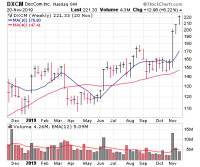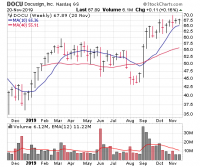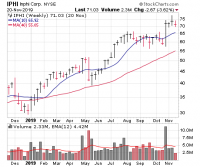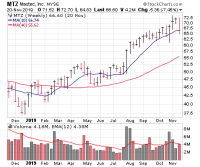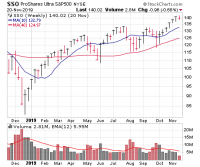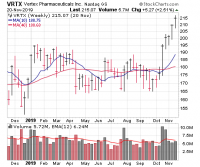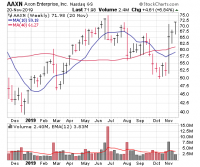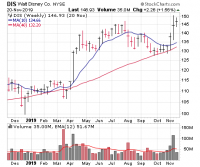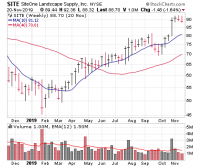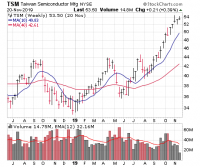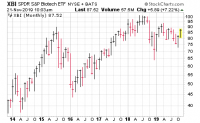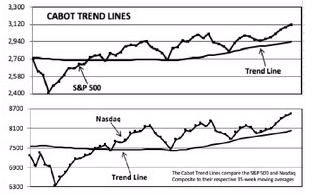The market and leading stocks have hit a few potholes during the past couple of days, and given the recent run and some short-term measures, more selling wouldn’t be shocking. But bigger picture, the outlook remains sunny: The trends are up for the major indexes and many fresh leading stocks have emerged. We’ve done a bunch of buying during the past month, though we’re still holding 24% on the sideline as we see how these new buys act.
In tonight’s issue, we talk about our market view, give you our latest thoughts on all our recommendations and write about the two themes that we think are leading the market higher, at least for now. Throw in some new ideas and there’s something for everyone in tonight’s Growth Investor.
Cabot Growth Investor 1433
[premium_html_toc post_id="191338"]
Mostly Sunny, Chance of Passing Showers
Seven weeks ago, the market was getting hit and growth stocks were looking awful. We were definitely cautious, but on this page we also wrote the following:
“We don’t want to sound too negative. It’s still a bull market, and we remain very optimistic that the next major move will be on the upside. Thus, we’re not looking to turn defensive and aren’t predicting doom and gloom; the past few months of sloppy, news-driven action are probably setting the stage for the next sustained upmove.”
Since then, the action has been about as good as we could have hoped for—the major indexes have not only pushed ahead, but done so in a relatively persistent manner despite some headlines that, during the spring and summer, caused sellers to dig in. And while growth stocks aren’t running up the score, more and more new leaders (especially medical- and 5G-related leaders—see our writeup toward the end of this issue) have emerged, most out of very long launching pads.
There are never any sure things in the market, but the evidence suggests that the long-awaited sustained uptrend is now underway, which has prompted us to put a bunch of money to work during the past few weeks, helping us land what we think are a few of the true leaders of this rally.
Of course, it’s not a perfect picture out there. During the past week or two, we’ve seen the broad market stagnate a bit, with small- and mid-cap indexes lagging (both are still battling multi-month resistance). A few leaders, both growth and cyclical, have hit potholes. And many “overbought” measures are at levels that, during the past few months, preceded multi-week market corrections.
Still, we think this is a classic forest vs. the trees type of situation. The trees (smaller) view says that the market’s come a long way in a short time, most of the worries of the past few months have been (temporarily) forgotten, and a pullback could be in the offing. We agree that there’s a chance of passing showers.
But the view of the forest (big picture) shows that stocks only recently emerged from a five-month choppy period, which, for most indexes, was part of a larger 20-month period of no progress! And, as mentioned above, many new leaders have gotten going from equally long consolidations that wore out all the weak hands. From this perspective, we might just be launching a trend that lasts longer and goes farther than most expect.
What to Do Now
As always, we’ll change if the evidence does, but right now it’s mostly sunny and you should be leaning bullish. Last week, we added MasTec (MTZ), filled out our position in Teladoc (TDOC) and started a half position in Dexcom (DXCM), leaving us with around 24% in cash.
Model Portfolio Update
Day by day, week by week, the evidence has continued to improve, both for the market (both of our trend-following measures are solidly positive) and for individual stocks, many of which have broken out of long launching pads and, encouragingly, have held or built on those gains. That’s a big reason we’ve put two-thirds of our early-October cash hoard back to work during the past few weeks.
Now we want to see how things progress (or not). So far, most of our stocks are off to good starts or are otherwise acting fine, but given that we’ve just added a few names, the key will be if the stocks remain under accumulation, especially if this week’s trade-related selling continues.
Of course, if we do see a good entry point in a fresh leader, we won’t hesitate to put some money to work. But tonight, we’re going to stand pat and see how our current crop of names shake out.
Current Recommendations
Dexcom (DXCM 219)—While diabetes stocks aren’t an official “sector” in the market, it’s one of our favorite growth themes, as millions of patients are still pricking themselves many times a day to get glucose readings (and most are also still injecting themselves with insulin, too). But technology advancements are changing all of that, and Dexcom’s G6 continuous glucose monitor is one of the leaders in the field, allowing users to forego fingersticks and recalibrations, digitally share the data with others automatically (big if you have diabetic kids, for instance) and, most importantly, keep glucose at safe levels. There is competition from Abbott and others, but (a) most believe Dexcom currently has the best mousetrap and (b) the market is so big that all the big players should benefit. As for the stock, it did nothing for 14 months, but the recent earnings report catapulted DXCM to new highs on massive volume and the stock has continued higher since. It looks like a liquid leader in the medical field to us. We bought a half position last Friday (via our update Thursday evening) and are off to a good start; if it continues to act well, we’ll look to fill out our position, though we’d prefer to do so on a bit of weakness or a few days of consolidation. BUY A HALF.
DocuSign (DOCU 70)—DOCU looks fine overall, with the stock briefly nosing to new highs this morning before being contained by the market. That said, we’re keeping our eyes open—the stock was actually pushing ahead while most growth stocks struggled in September/early October, but since the market and many leaders got going, it’s stagnated, with resistance in the 70 area. We wouldn’t say that’s a reason to worry much, as we’ve seen many stocks that acted resiliently during a down period take their time in getting going in the ensuing uptrend. Plus, as we’ve written before, the stock’s incredible blastoff in September (three straight weeks of huge-volume accumulation) and DocuSign’s rare story (rapid and reliable growth) bode well. Earnings are likely out in early/mid-December, and that could tell the tale. In the meantime, we’re just playing it by the book—DOCU’s action is normal, and it wouldn’t take much (a close above 71 or so) for it to be freewheeling on the upside. If you own some, sit tight, and if you don’t, we’re OK buying some around here, albeit with a stop in the 61 area. BUY.
Inphi (IPHI 69)—The advance in chip stocks has become a bit more selective, with many (especially chip equipment titles) pausing or pulling back a bit, and Inphi is no exception, easing a few points in recent days. But the chart looks fine (still well above its prior consolidation) and the story is as bright as ever. It looks like the firm’s recently announced acquisition of a firm named eSilicon (for $216 million) will be a hit, as it not only expands Inphi’s capabilities in the data center and cloud markets but also proves accretive in both 2020 (in a smaller way) and especially 2021 (possibly boosting earnings per share by 20% or so). There are never any sure things, but we remain very optimistic about the business (spending is just beginning to ramp for the company’s data center interconnect, long haul and metro gear) and like the position of the stock, which broke out of a two-plus-year base in July and gapped out of a flat rest period three weeks ago. If the market pulls in, IPHI could retreat further, but we think the next big move is up. BUY.
MasTec (MTZ 65)—Most of our recent additions have gotten off to good starts (which in and of itself is a good sign for the overall market), but MasTec has been the exception, and the reason for the weakness is bizarre, something I haven’t come across in my 20-plus years here. Basically, the company lent a couple of major owners some money so that they could pay off other debts related to their investments in a Major League Soccer franchise, and are using their shares as collateral. (They made it a point to say they won’t be selling any actual shares.) Don’t get us wrong, it’s not the best look (it has the feel of a good-old-boy sort of transaction), but it has no effect on the firm’s business prospects at all, which are very bright in a variety of areas (renewable energy, 5G, pipelines, etc.). Nevertheless, MTZ plunged on Wednesday after the news broke. It’s obviously disappointing, and given the action it’s prudent to switch to a Hold rating—but we’re also aiming to give shares a little wiggle room from here, thinking this week’s action could be a shakeout on superficial news. We’ll be watching closely. HOLD.
ProShares Ultra S&P 500 Fund (SSO 140)—Leveraged index funds are the type of thing you’d brag about at a cocktail party, but that’s OK with us—with the market in a newly-strong uptrend, SSO is going along for the ride. Short-term, some wobbles in the major indexes are always possible, and if something unexpected bursts on the world stage, maybe a sharper correction occurs. But it’s best to just go with the odds, and right now most of the evidence is bullish—the intermediate-term (Cabot Tides) and longer-term (Cabot Trend Lines) are positive and the smoothness of the recent advance (both for the U.S. and other countries) bodes well when looking out a few months. Bottom line, a leveraged long fund is a good way to get a foothold in the bull market. We’ll stay on Buy, though dips of a couple of points would be better to jump on. BUY.
Qorvo (QRVO 101)—QRVO has been very tight in the two weeks since its monstrous earnings-induced breakout, which is generally a good sign the stock is under accumulation. Fundamentally, the biggest piece of data of late actually came from Qualcomm’s Investor Day this week—whereas some analysts had been thinking 200 million 5G smartphones would be sold next year, Qualcomm sees the figure at a whopping 450 million, with another 750 million shipped in 2021! There’s obviously competition from Skyworks, Broadcom and the like, but given Qorvo’s recent earnings beat and giant hike in guidance (it boosted Q4 revenue guidance by 12% and earnings by 23%!), it seems clear the firm will be a big beneficiary of the trend. Back to the stock, the longer it can hold its recent move without giving up any ground, the greater the odds it continues higher. We own a half-sized position but will look to average up on some follow-on strength. BUY A HALF.
Teladoc (TDOC 77)—TDOC has run into a little resistance around 80, but it’s well above its breakout level (down around 72) and, like most emerging leading stocks, hasn’t suffered any big-volume selling. The company has been quiet on the news front since earnings; it is presenting at an investor conference in early December, though the top brass usually doesn’t break any new ground at those kind of events. Looking ahead, execution will be the key, as there’s obviously a massive opportunity to both gain new members over time and boost engagement of their current crop of users. If management pulls the right levers, we think TDOC can go far. BUY.
Vertex Pharmaceuticals (VRTX 216)—As opposed to Teladoc, Vertex Pharmaceuticals has been pumping out news left and right during the past few weeks concerning drug approval applications (it submitted its new triple combination treatment for cystic fibrosis to Europe’s FDA regime), country approvals (England, Northern Ireland and Wales gave the thumbs up to the new triple combo), reimbursement (in France for one of its CF drugs) and more. The stock has gotten off to a nice start for us, and its big breakout-and-follow-through action after a couple of years in the wilderness hints that a major upmove is getting going, as do the bulky earnings estimates (earnings likely to double during the next two years). We’ll stay on Buy, though if you don’t own any, consider starting small here or looking for dips of a few points. BUY.
Watch List
- Axon Enterprise (AAXN 72): The chart still needs a bit of work, but we think the story has legs and we like the year-long rest period the stock may be coming out of. See more later in this issue.
- Peloton (PTON 30): Recent IPOs aren’t our favorite lake to fish in, but Peloton has the makings of a winner, with a strong, liquid stock, a popular consumer product and triple-digit revenue growth.
- Sea Ltd. (SE 37): PDD went over the falls after earnings, but Sea—a fast-growing games and e-commerce player in Singapore and Asia as a whole—did the opposite, surging back toward its highs after sales nearly tripled in Q3.
- Tesla (TSLA 354): Every day that goes by adds to the evidence that Tesla has turned the corner both fundamentally (analysts see solid earnings going forward) and on the chart (stock continues to hit new recovery highs). The first normal pullback should be buyable.
Other Stocks of Interest
Axon Enterprises (AAXN 72)—Axon Enterprises used be known as Taser, the leader in electric weapons (basically fancy stun guns) for law enforcement. But the company has transformed itself in recent years, not just in its name, but in its business model—instead of relying on one-time sales to various police departments and agencies, Axon is now driven by recurring revenue through a suite of products (including its Evidence.com cloud-based video system) that can take in, edit, share, store and analyze video from its body cameras and in-car video systems. And the firm is even emphasizing recurring bundle packages for its weapons, too, with unlimited cartridges and training being offered. Weapon sales still make up a bit more than half of revenue, but 55% are now sold on a recurring payment plan and are growing decently overall (sales up 13%). But newer products (body cameras and the like—sales up 45% in Q3) and cloud-related revenue (up 42%) are now the growth drivers. In fact, the company’s annual recurring revenue was up to $141 million at the end of September (up 29% from a year ago), while total future revenue under contract was $1.13 billion (up 38%)! Profits and cash flow are strong (Axon has no debt, which is a plus), and analysts see the growth continuing next year (sales up 16%, earnings up 27%, EBITDA up a big 42%). As Axon morphs into a more dependable growth outfit, we think an increasing number of big investors will feel comfortable building positions. As for the stock, it had a huge run into mid 2018 (we had it on our watch list for a while) but then fell hard and has been consolidating for more than a year. However, the big earnings move two weeks ago was a great sign that a bottom is in—now it’s a matter of seeing if shares can set up properly. It’s worth watching.
Disney (DIS 147)—We don’t follow most mega-cap stocks that are found in the Dow, but there are a few things that we find very intriguing with Disney. First, despite being a behemoth, the stock can move; in fact, from its breakout in early 2012 to its peak in mid 2015, the stock nearly tripled, which isn’t chump change. Second, the focus of investors has shifted from the company’s stodgy businesses to its Disney+ streaming offering, which has a rich content library, including Star Wars and Pixar films, thousands of episodes of various shows, and some original content to start (and more to come). And third, while the initial projections were big (management initially guesstimated 60 to 90 million Disney+ subscribers by 2024), last week’s launch proved better than even the most optimistic forecasts, with 10 million signing up within just the first two days! And don’t forget that Disney also controls most of Hulu and ESPN+, both of which are offered via bundle with Disney+ ($13 per month for all three, vs. $7 per month just for Disney+), all of which should grow nicely as the company puts its efforts into building a streaming empire. The trick is that Disney is investing heavily, so earnings are sagging (down sharply in the past 12 months, and likely to be flat-ish through mid 2020), but after that it’s appearing increasingly likely that the firm will have another multi-year growth period. Finally, the stock is showing signs of life, with a massive breakout of a nearly four-year rest when the streaming plans were announced this spring, and now after a two-month pullback, it’s coming alive again. We think DIS could surprise on the upside in the months ahead.
SiteOne Landscape (SITE 87)—SiteOne is too thin for us ($25 million or so of daily dollar volume), but it’s got one of our favorite long-term growth stories, and after getting taken apart late last year, the stock has found buyers again. So what’s the big idea? The company is the largest and only national wholesale distributor of landscape supplies; it’s four times the size of its nearest competitor (serves residential and commercial customers; offers 120,000 products through more than 550 branches in 45 states), yet it has just 11% market share in this fragmented industry. Landscaping isn’t revolutionary, of course, but SiteOne’s business approach is lucrative—the firm is busy “rolling up” industry competitors, many of which are local one- or two-location operations. In 2017, it bought eight firms with $130 million in sales and 26 branches; last year it added 13 outfits with $230 million in sales and 78 branches; and so far this year, it’s added another eight operations with 17 branches. (The buyouts also create plenty of purchasing synergies and cross-selling opportunities.) Throw in some slow, steady organic growth (7% in Q3) and we see no reason why SiteOne can’t grow in the low- to upper teens annually for many, many years as it gobbles up local outfits across the country. The stock came public in 2016 and had a beautiful two-year run until it was cut in half last year. The recovery in 2019 was good (not great), but now the buyers are flexing their muscles; after a quick early-October shakeout, SITE has popped back toward its all-time highs following its Q3 report. Pullbacks are possible, but it looks like the stock’s back on track.
Medical, 5G Take Leadership Baton from Software
Knowing the overall environment for the market and growth stocks is probably the most important element of investing. But once you’ve determined the bulls are in control, the next thing is to take an unbiased look at what areas—and what stocks in particular—are the real leaders of the market.
For much of the 2018 advance (while it lasted) and the first few months of this year, cloud software and cybersecurity names were clearly the favorites. But while some of those titles have found their sea legs, the fact is most of them have already had big prolonged runs, decisively broke down and are sitting well off their highs. Take Okta (OKTA), which was a solid winner for us—the stock originally broke out in February 2018 at 32 and ran as high as 142 (up nearly 350%) over 17 months. It’s possible OKTA and its peers set up again, and if they do, we’ll be watching. But, while they’re not bearish looking, they also don’t appear to be leaders at this time.
Instead, it’s looking more and more like two areas are attracting the big money—5G, which has been long talked about but is just now finally seeing buyers, and biotech and medical, where many names in the group have been out of favor for years.
The attractive thing about 5G is that it looks as though it will boost demand in a variety of manners, both on the consumer end (new smartphones) and the back end (building the wireless network itself). Qorvo (QRVO) is our pick of the litter when it comes to the smartphone side of 5G; we think the firm’s position and blowout Q3 report portends very good things as hundreds of millions of 5G phones are sold during the next couple of years.
If you’re looking for less volatility, Taiwan Semiconductor (TSM) may be for you—this giant foundry broke out in September and has enjoyed a very persistent advance in the weeks since. Any dips (especially to the 10-week line) would be tempting. On the infrastructure side of things, everything from cell tower leasing (Crown Castle (CCI) is one, though the chart needs a bit of work) to network testing (Keysight (KEYS) is a leader there) should be positively impacted as telecoms ramp 5G spending.
As for medical stocks, it’s admittedly a very broad category (biotech, devices, health care, technology, etc.), and not every stock will swim together. But for some broad perspective, check out the monthly chart of the S&P Biotech Fund (XBI), which has dozens of components and isn’t weighted just toward the big-cap names—it had a huge run into mid-2015, but four years later, it’s at the same level!
Now, though, it appears the weak hands are out, with many medical-related names acting well. We have three in the Model Portfolio (DXCM, TDOC, VRTX), so we may not gobble up another, but there are plenty of tempting issues, including Acadia Pharmaceuticals (ACAD), Neurocrine Biosciences (NBIX) and Insulet (PODD), each of which we’ve written up during the past few months.
Obviously, the situation can always change, with some leaders falling by the wayside and possibly other areas coming to the fore. But so far, it certainly looks like 5G- and medical-related stocks are where big investors are focusing.
Be Careful with Overbought Indicators
As the market has gone straight up during the past six-plus weeks, we’ve seen a lot of write-ups on various overbought measures that are now flashing red—put-call ratios imply complacency, sentiment surveys tell us many investors are becoming bullish and the indexes themselves are stretched to the upside. The past three times this situation occurred, the market has pulled back a few percentage points.
But oftentimes, these overbought (and oversold) indicators are more descriptive than predictive. The reason these measures pinpointed near-term tops in the past few months is because we were in a choppy environment. Conversely, the fact that leading stocks and the major indexes remain resilient now is a good sign that the market has (finally) changed character.
To be clear, we’re not saying overbought indicators are useless, or that the market won’t retreat soon; when things are stretched it’s a good idea to get choosier on the buy side and/or start with smaller positions, which is what we’re doing now. But our point is that things often can stay overbought or oversold for many weeks—it’s good to be aware of, but decisions should be made based on the actual action of the market and leading stocks.
Cabot Market Timing Indicators
Shorter-term, some secondary signs tell us a pullback may be coming, so being discerning on the buy side makes sense. But we’re more focused on the larger picture—with the trends up and investors just barely coming off the sideline, the odds favor higher prices down the road.
Cabot Trend Lines: Bullish
The major indexes had a very choppy few months from May through October, but all three pullbacks found support at their Cabot Trend Lines, and during the past six weeks the market has lifted to the upside—at last week’s close, both the S&P 500 (by 6.2%) and Nasdaq (by 6.5%) were well above their 35-week lines, telling us the primary trend is pointed strongly up.
Cabot Tides: Bullish
Our Cabot Tides remain positive, with all five indexes we track (including the S&P 600 SmallCap) holding nicely above their lower (50-day) moving averages. Granted, some indexes like this one are still battling resistance around their highs of this year, which could be an issue. But there’s no question the intermediate-term trend is up, and we like the tame giveback so far in the S&P 600 following a persistent month-long advance. Long story short, the odds still favor higher prices in the weeks ahead.
Cabot Real Money Index: Neutral
While investors haven’t leapt into the market, they have stopped running for the hills, with the five-week sum of money flows into equity funds and ETFs nosing above the zero line for the first time all year. That keeps our Real Money Index, which is best used as a shorter-term contrary indicator, stuck in neutral territory. Going forward, we’ll be watching to see if buying picks up should the market remain healthy.
Charts courtesy of StockCharts.com
The next Cabot Growth Investor issue will be published on December 5, 2019.
Cabot Wealth Network
Publishing independent investment advice since 1970.
CEO & Chief Investment Strategist: Timothy Lutts
President & Publisher: Ed Coburn
176 North Street, PO Box 2049, Salem, MA 01970 USA
800-326-8826 | support@cabotwealth.com | CabotWealth.com
Copyright © 2019. All rights reserved. Copying or electronic transmission of this information is a violation of copyright law. For the protection of our subscribers, copyright violations will result in immediate termination of all subscriptions without refund. No Conflicts: Cabot Wealth Network exists to serve you, our readers. We derive 100% of our revenue, or close to it, from selling subscriptions to its publications. Neither Cabot Wealth Network nor our employees are compensated in any way by the companies whose stocks we recommend or providers of associated financial services. Disclaimer: Sources of information are believed to be reliable but they are not guaranteed to be complete or error-free. Recommendations, opinions or suggestions are given with the understanding that subscribers acting on information assume all risks involved. Buy/Sell Recommendations: All recommendations are made in regular issues or email alerts or updates and posted on the private subscriber web page. Performance: The performance of this portfolio is determined using the midpoint of the high and low on the day following the recommendation. Cabot’s policy is to sell any stock that shows a loss of 20% in a bull market or 15% in a bear market from the original purchase price, calculated using the current closing price. Subscribers should apply loss limits based on their own personal purchase prices.


